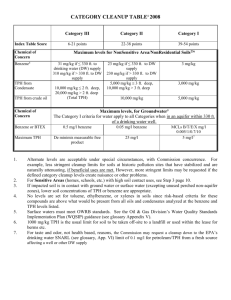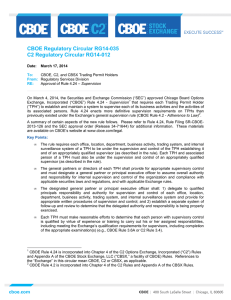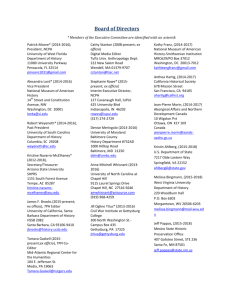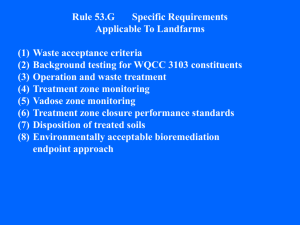O A No Coding Variant of the Tryptophan Hydroxylase
advertisement
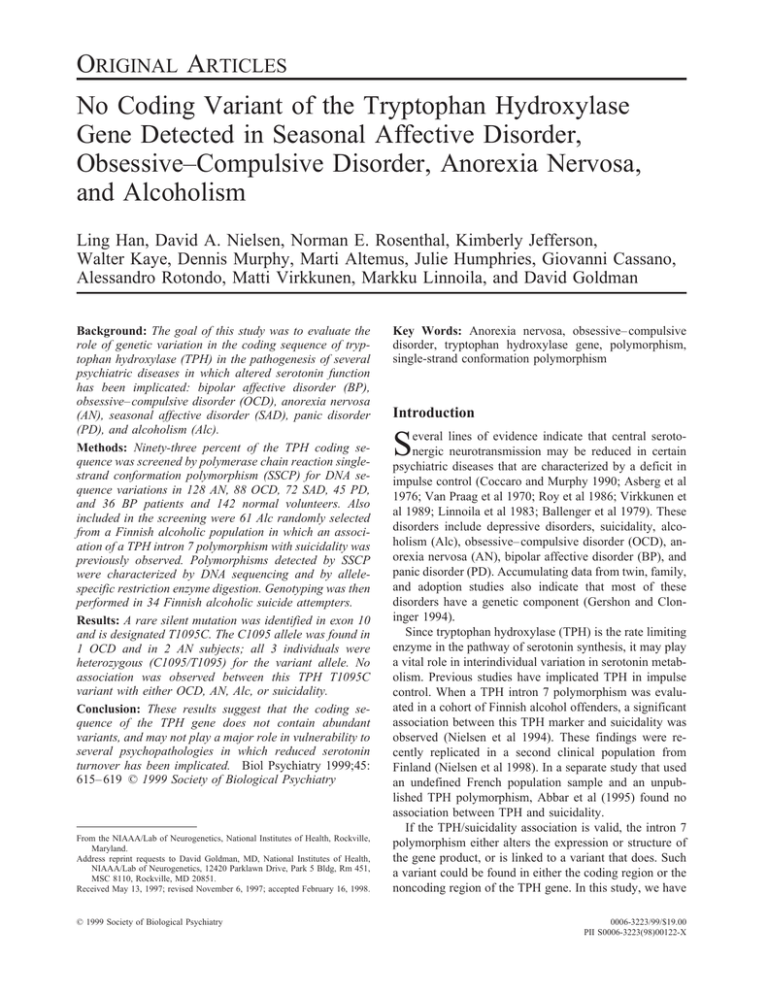
ORIGINAL ARTICLES No Coding Variant of the Tryptophan Hydroxylase Gene Detected in Seasonal Affective Disorder, Obsessive–Compulsive Disorder, Anorexia Nervosa, and Alcoholism Ling Han, David A. Nielsen, Norman E. Rosenthal, Kimberly Jefferson, Walter Kaye, Dennis Murphy, Marti Altemus, Julie Humphries, Giovanni Cassano, Alessandro Rotondo, Matti Virkkunen, Markku Linnoila, and David Goldman Background: The goal of this study was to evaluate the role of genetic variation in the coding sequence of tryptophan hydroxylase (TPH) in the pathogenesis of several psychiatric diseases in which altered serotonin function has been implicated: bipolar affective disorder (BP), obsessive– compulsive disorder (OCD), anorexia nervosa (AN), seasonal affective disorder (SAD), panic disorder (PD), and alcoholism (Alc). Methods: Ninety-three percent of the TPH coding sequence was screened by polymerase chain reaction singlestrand conformation polymorphism (SSCP) for DNA sequence variations in 128 AN, 88 OCD, 72 SAD, 45 PD, and 36 BP patients and 142 normal volunteers. Also included in the screening were 61 Alc randomly selected from a Finnish alcoholic population in which an association of a TPH intron 7 polymorphism with suicidality was previously observed. Polymorphisms detected by SSCP were characterized by DNA sequencing and by allelespecific restriction enzyme digestion. Genotyping was then performed in 34 Finnish alcoholic suicide attempters. Results: A rare silent mutation was identified in exon 10 and is designated T1095C. The C1095 allele was found in 1 OCD and in 2 AN subjects; all 3 individuals were heterozygous (C1095/T1095) for the variant allele. No association was observed between this TPH T1095C variant with either OCD, AN, Alc, or suicidality. Conclusion: These results suggest that the coding sequence of the TPH gene does not contain abundant variants, and may not play a major role in vulnerability to several psychopathologies in which reduced serotonin turnover has been implicated. Biol Psychiatry 1999;45: 615– 619 © 1999 Society of Biological Psychiatry From the NIAAA/Lab of Neurogenetics, National Institutes of Health, Rockville, Maryland. Address reprint requests to David Goldman, MD, National Institutes of Health, NIAAA/Lab of Neurogenetics, 12420 Parklawn Drive, Park 5 Bldg, Rm 451, MSC 8110, Rockville, MD 20851. Received May 13, 1997; revised November 6, 1997; accepted February 16, 1998. © 1999 Society of Biological Psychiatry Key Words: Anorexia nervosa, obsessive– compulsive disorder, tryptophan hydroxylase gene, polymorphism, single-strand conformation polymorphism Introduction S everal lines of evidence indicate that central serotonergic neurotransmission may be reduced in certain psychiatric diseases that are characterized by a deficit in impulse control (Coccaro and Murphy 1990; Asberg et al 1976; Van Praag et al 1970; Roy et al 1986; Virkkunen et al 1989; Linnoila et al 1983; Ballenger et al 1979). These disorders include depressive disorders, suicidality, alcoholism (Alc), obsessive– compulsive disorder (OCD), anorexia nervosa (AN), bipolar affective disorder (BP), and panic disorder (PD). Accumulating data from twin, family, and adoption studies also indicate that most of these disorders have a genetic component (Gershon and Cloninger 1994). Since tryptophan hydroxylase (TPH) is the rate limiting enzyme in the pathway of serotonin synthesis, it may play a vital role in interindividual variation in serotonin metabolism. Previous studies have implicated TPH in impulse control. When a TPH intron 7 polymorphism was evaluated in a cohort of Finnish alcohol offenders, a significant association between this TPH marker and suicidality was observed (Nielsen et al 1994). These findings were recently replicated in a second clinical population from Finland (Nielsen et al 1998). In a separate study that used an undefined French population sample and an unpublished TPH polymorphism, Abbar et al (1995) found no association between TPH and suicidality. If the TPH/suicidality association is valid, the intron 7 polymorphism either alters the expression or structure of the gene product, or is linked to a variant that does. Such a variant could be found in either the coding region or the noncoding region of the TPH gene. In this study, we have 0006-3223/99/$19.00 PII S0006-3223(98)00122-X 616 L. Han et al BIOL PSYCHIATRY 1999;45:615– 619 Table 1. Primers Used to Amplify the TPH Coding Region Exon 2 3 4 5&6 7 8 9 10 11 Downstream Primers Product Length (bp) Annealing Temp (°C) TTTTCAGGGCTTTTA 39 TTGAACTTACCATCTTCCT 39 GAAAATACTTACAGGAT 39 GGAGACATCTTCCAA 39 TGATGAATTCCTGGCTGAAA 39 AGCTAATTCCAGATTTATAC 39 CCCCAAGTATGTTCCATAGT 39 TATACTGTACCTCATCTT 39 CTGGCTACTGTAGA 39 170 200 125 411 230 179 225 173 191 45 55 45 55 54 54 59 46 40 Upstream Primers 59 59 59 59 59 59 59 59 59 TTTAGCCCGTAGTCT 39 ACATAGGAGAAGCATGT 39 TAAATTTTACAGGTATG 39 AATTATCAGGGCTTC 39 ATGCTGCAGTCAGGGGTCTA 39 GCAGCGTGACAAACTTGTAC 39 AATATTGATGTTCTTTTGCA 39 CTTTGATTCACTGACTCTT 39 AAATAGAGAATTTAC 39 59 59 59 59 59 59 59 59 59 screened the coding region of the TPH gene in a randomly selected sample from the same alcoholic Finnish population in which the TPH/suicidality association was observed. We also screened the TPH coding sequence in several other disorders in which serotonin dysfunction has been implicated: AN, OCD, PD, BP, and seasonal affective disorder (SAD). Methods and Materials Clinical Populations Genomic DNA was isolated either from Epstein–Barr virus immortalized lymphoblastoma cell lines or directly from peripheral blood. The ethnic makeup of the sample included American Indians, and Caucasians of U.S., Italian, and Finnish origin. The sizes of the clinical populations were AN (n 5 128), OCD (n 5 88), SAD (n 5 72), Alc (n 5 61), PD (n 5 45), and BP (n 5 36). In addition, we evaluated 142 normal Caucasian volunteers (NV), who were also psychiatrically screened. The diagnoses were made by experienced psychiatrists according to DSM-III-R criteria following structured interviews. All subjects participated following informed consent and were studied under human research protocols approved by NIMH (OCD, SAD, BP, Alc), NIAAA (PD, NV), the University of Pittsburgh (AN), the University of Pica (AN, OCD, PD), and the University of Helsinki (Alc). DNA Amplification by PCR DNA amplification was performed on 9 regions of the TPH gene corresponding to exons 2, 3, 4, 5, 6, 7, 8, 9, 10, and 11 (Boularand et al 1990; Craig et al 1991), and covered 93% of the TPH coding sequence (the noncoding exon, exon 1, was excluded). Nine primer pairs were synthesized to amplify these fragments, which included the 59 and/or 39 end exon/intron junctions of exons 2, 5, 6, 7, 8, 9, and 10. The sequences of the synthesized primers and the lengths of the amplified products are listed in Table 1. Amplification was performed with 50 ng DNA, 0.5 mL of 103 polymerase chain reaction (PCR) buffer containing 200 mmol/L Tris-HCl, 0.5 mol/L KCl, 20 mmol/L MgCl2, and 1 mg/mL bovine serum albumin (BSA), 0.8 mmol/L of each primer, 0.2 mmol/L each of deoxycytidine triphosphate (dCTP), deoxyguanosine triphosphate, deoxythymidine triphosphate, and deoxyadenosine triphosphate, 0 –2 mmol/L of MgCl2 individualized for each exon, 0.25 U of AmpliTaq (Perkin Elmer Cetus), and 0.5 mCi [a33P] dCTP in a total volume of 5 mL per reaction. Samples were amplified for 30 cycles, each consisting of 15 sec at 95°C, 15 sec at 40–59°C (individualized for each exon as indicated in Table 2) and 30 sec at 72°C in a Perkin Elmer 9600 thermocycler. Table 2. Populations Screened by SSCP for the TPH Coding Sequence Variation For All 9 Fragments Population AN OCD SAD ALC PD BP NV Total For Exon 10 Sources Mean 6 s.e.m. (9) Minimum N US & Italy US & Italy US Finland US & Italy US US 56.9 6 11.7 54.6 6 4.3 40.0 6 4.6 45.3 6 7.1 42.1 6 1.9 32.4 6 0.4 62.0 6 12.5 32 32 32 32 32 32 32 128 88 72 61 45 36 142 333.3 6 35.8 224 572 Coding Variants of TPH Gene BIOL PSYCHIATRY 1999;45:615– 619 617 Single-Strand Conformation Polymorphism (SSCP) Analyses PCR products were diluted in 10 mL SSCP buffer consisting of 95% deionized formamide, 10 mmol/L NaOH, 0.05% Bromophenol blue, and 0.05% xylene cylanol and incubated at 97°C for 10 min for denaturation. After incubation on wet ice for 2 min, 4 mL of the denatured PCR product was loaded onto a nondenaturing, sequencing-type Mutation Detection Enhancement MDE (FMC) gel in 0.6% TBE buffer. Electrophoresis was carried out at 4°C for 16 –18 hours at 500 V. DNA bands were visualized by autoradiography at 270°C and by phosphoimaging (Phosphorimager 400, Molecular Dynamics). To increase the sensitivity of SSCP, longer fragments resulting from amplification of exons 5 and 6, 7, and 9 were digested with restriction enzymes (New England Biolabs) to yield subfragments of desired length prior to electrophoresis in a nondenaturing gel. The restriction digestions were performed in a total volume of 15 mL containing 5 mL of the PCR products and 1.5 mL of the manufacturer’s recommended buffer. The enzymes used were: 0.25 mL (5 units) TaqaI for exon 7, yielding fragments 95 and 135 in length; 0.7 mL (7 units) HinfI for exon 9, yielding fragments of 74 and 151 in length; and 0.2 mL Dra I (4 units) plus 0.5 mL ScrF I (2.5 units) for exons 5 and 6, yielding fragments of 89, 135, and 187 in length, respectively. Sequencing and Allele-Specific Restriction Enzyme Digestion For automated sequencing, 5 ng of genomic DNA was amplified as described above in a total volume of 50 mL per reaction. The PCR product and 10 mL loading dye (0.25% Bromophenol blue, 0.25% xylene cylanol, and 30% glycerol) were loaded onto a 2% agarose gel. Following electrophoresis at 150 V for 1 hour in TBE buffer, bands representing the specifically amplified products were cut out, and the DNA was purified using the JETsorb protocol (Genomed Inc.). Sequencing was performed bidirectionally and by using 1 mL of each primer (3.2 nmol/L), 2.5 mL of purified PCR product, and 6 mL Dye Terminator Cycle Sequencing Ready Reaction Mix with AmpliTaq DNA polymerase (Perkin Elmer Cetus). The resulting mixture was incubated for 25 cycles of 10 sec at 96°C, 5 sec at 50°C, and 4 min at 60°C. Extension products were further purified by ethanol precipitation and resuspended in 250 mL 70% ethanol. The purified DNA fragments were resuspended in 6 mL deionized formamide and incubated at 95°C for 5 min. Then, 4 mL was loaded on a 6% acrylamide gel and subjected to electrophoresis in TBE buffer at room temperature for 10 hours in a ABI 373 automated sequencer. To confirm the sequencing result and to genotype the variant in additional samples, the PCR products of exon 10 were digested with BsmA I or its isoschizomer Alw26 I. BsmA I (and Alw26 I as well) should cut the 1095C alleles into two fragments of 75 and 98 bp, while the 1095T allele is not cleaved by this enzyme. The digestion reaction was carried out in a total volume of 15 mL consisting of 1.5 mL (7.5 U) BsmA I, 10 mL PCR product plus 1.5 mL of the recommended buffer, and 0.2 mL Figure 1. Detection of T1095C variant by SSCP mobility shift. Three heterozygous individuals are labelled in the figure. 1003 (3 ng) BSA and incubated for 16 hours at 55°C (for BsmA I) or 37°C (for Alw26 I). Twelve microliters of the digested sample was loaded on a 10% acrylamide gel and electrophoresed at 35 mA in 13 TBE buffer for 20 min. DNA bands were visualized by ethidium bromide staining. Results Using the SSCP method to detect sequence variation, we screened a minimum of 224 and a maximum of 572 DNA samples (333 6 36, means 6 SEM) for each of the nine TPH exons (see Tables 1 and 2). Three patients, 1 OCD and 2 AN, showed similar SSCP mobility shifts with the amplification products of exon 10 (Figure 1). Dideoxysequencing detected a T to C transition at position 1095 (Figure 2). This transition does not result in an amino acid substitution; the alternate triplet codons CTT and CTC both encode leucine. All 3 individuals with the 1095C variant were heterozygous, as confirmed by sequencing (Figure 2) as well as by BsmA I digestion (data not shown). The frequency of the rare 1095C allele was .0026 (3/1144) for the whole sample, .0078 (2/256) for the AN group (vs. NV: x2 5 2.23, df 5 1, p . .1), and .0057 (1/176) for OCD (vs. NV: x2 5 1.62, df 5 1, p . .1). No polymorphism was found in the other diagnostic groups or in normal volunteers. Analyses of exons 2, 3, 4, 5, 6, 7, 8, 618 L. Han et al BIOL PSYCHIATRY 1999;45:615– 619 Figure 2. Sequencing of TPH T1095C heterozygous [Fig 2A 1 and 2] individuals and T1095 homozygous individuals [Fig 2B 1 and 2]. 9, and 11 revealed no other polymorphism in the TPH coding region. In addition, we genotyped 34 alcoholic suicide attempters from the same Finnish alcoholic population in which the association of a TPH intron 7 polymorphism with suicidality was observed (Nielsen et al 1994). All 34 of these patients were homozygous for the 1095T allele (data not shown). vulnerability to mental disorders screened in the present study, at least in SAD, OCD, AN, and Alc, where sample sizes allowed for reasonable statistical inference (n 5 61–128, p . .1). The negative result reported here is also in line with the available, but limited results from variant searches conducted on the TPH gene to date. Previously the TPH coding sequence from 2 individuals homozygous for the intron 7 marker associated with suicidality was sequenced by Nielsen et al in press. They detected no alteration in DNA sequence or messenger RNA structure. The only TPH variants detected remain synonymous coding sequence variants and variants in noncoding sequences, including multiple variants in the TPH promoter region (Rotondo et al in submission); however, variants may be found elsewhere in the TPH gene. Unscreened regions include the portions of the gene more than 2 kb upstream, exon 1, introns, the 3° untranslated region, as well as the 7% of the coding region we have not screened. Future efforts on the role of TPH in mental disorders could focus on the role of these promoter variants and other variants yet to be detected. A role for TPH coding sequence variants in mental disorders is not yet excluded. Although SSCP is a sensitive and widely utilized screening method for DNA polymorphisms, its efficiency varies with the DNA region analyzed and electrophoresis conditions such as temperature and gel solution (Orita et al 1989; Glavac and Dean 1993; Liu and Sommer 1995). We have enhanced the sensitivity of the procedure by predigesting long PCR products with restriction enzyme, adding 10% glycerol to MDE gel, and performing electrophoresis at 4°C; however, the sensitivity of the procedure we used is typically about 85% (Glavac and Dean 1993). Therefore, other screening methods like restriction endonuclease fingerprinting, Denaturing Gradient Gel Electrophoresis DGGE or direct sequencing could detect variants missed by the SSCP analyses performed here. Discussion In the present study, we screened the coding region of the TPH gene for polymorphism in several psychiatric populations in which serotonin dysfunction has been implicated. These samples also included alcoholic Finnish offenders in whom a TPH/suicidality association was observed with an intron 7 polymorphism (Nielsen et al 1994). The regions of TPH gene we screened covered 93% of the TPH coding region, which spans a total of 1332 nucleotides. The only detected variant was a synonymous substitution, CTT to CTC at position 1095. This substitution is highly unlikely to direct modification of TPH activity. In addition, the 1095C allele is relatively uncommon. This result may suggest that the genomic region encoding the TPH is generally not involved in differential References Abbar M, Courtet P, Amadeo S, Caer Y, Mallet J, BaldyMoulinier M, et al (1995): Suicidal behaviors and the tryptophan hydroxylase gene. Arch Gen Psychiatry 52:846 – 849. Asberg M, Thoren P, Traskman L, Bertilsson L, Rinberger V (1976): Serotonin depression: A biochemical subgroup within the affective disorders? Science 191:478 – 480. Ballenger JC, Goodwin FK, Major LF, Brown GL (1979): Alcohol and central serotonin metabolism in man. Arch Gen Psychiatry 36:224 –227. Boularand S, Darmon M, Ganem Y, Launay JM, Mallet J (1990): Complete coding sequence of human tryptophan hydroxylase. Nucleic Acids Res 18:4257. Coccaro EF, Murphy DL (1990): Serotonin in Major Psychiatric Disorders. Washington, DC: American Psychiatric Press. Coding Variants of TPH Gene Craig SP, Boularad S, Darmon M, Mallet J, Craig IW (1991): Localization of human tryptophan hydroxylase to chromosome 11p15.33p14b in situ hybridization. Cytogenet Cell Genet 56:157–159. Gershon ES, Cloninger CR (1994): Genetic Approaches to Mental Disorders. Washington, DC: American Psychiatric Press. Glavac D, Dean M (1993): Optimization of the single-stranded conformational polymorphism (SSCP) technique for detection of point mutation. Hum Mutat 2:404 – 414. Linnoila M, Virkkunen M, Scheinin M, Nuutila A, Rimoin R, Goodwin FK (1983): Low cerebrospinal fluid 5-hydroxyindolacetic acid concentration differentiates impulsive from nonimpulsive violent behavior. Life Sci 33:2609 –2614. Liu Q, Sommer SS (1995): Restriction endonuclease fingerprinting (REF): A sensitive method for screening mutation in long, contiguous segments of DNA. Biotechniques 18:470 – 477. Nielsen DA, Goldman D, Virkkunen M, Tokola R, Rawlings R, Linnoila M (1994): Suicidality and 5-hydroxyindoleacetic acid concentration associated with a tryptophan hydroxylase polymorphism. Arch Gen Psychiatry 51:34 –38. Nielsen DA, Lappalaineu J, Eggert M, Virkkunen M, Brown G, BIOL PSYCHIATRY 1999;45:615– 619 619 Goldman D, Linnoila M (1998): Alcoholism and suicidality are linked to and associated with tryptophan hydroxylase in Finns. Archives of Gen Psychiatry 55:593– 602. Nielsen DA, Jenkins GL, Stefanisko KM, Jefferson KK, Goldman D (1997): Sequence, splice site and population frequency distribution analyses of the polymorphic human tryptophan hydroxylase intron 7. Molecular Brain Research 45:145–148. Orita M, Iwahana H, Kanazawa H, Hayashi K, Sekiya T (1989): Detection of polymorphisms of human DNA by gel electrophoresis as single-strand conformation polymorphisms. Proc Natl Acad Sci USA 86:2766 –2770. Roy A, Agren H, Pickar D, Linnoila M, Doran AR, Cutler NR, et al (1986): Reduced CSF concentration of homovanillic acid and homovanillic acid to 5-HIAA ratio in depressed patients: Relationship to suicidal behavior and dexamethasone nonsuppression. Am J Psychiatry 143:1539 –1545. Van Praag H, Korf J, Puite J (1970): 5-Hydroxyindoleacetic acid levels in the cerebrospinal fluid of depressive patients treated with probenecid. Nature 225:1259 –1260. Virkkunen M, De Jong J, Linnoila M (1989): Psychobiological concomitants of history of suicide attempts among violent offenders and impulsive fire setters. Arch Gen Psychiatry 46:604 – 606.
